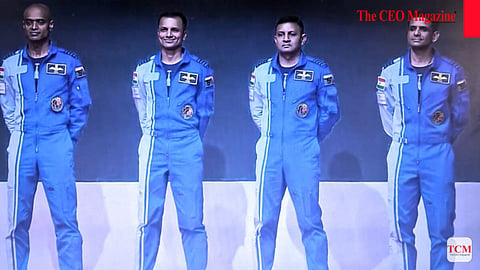
- News
- Women
- Magazine
- IndustryIndustry
- InsightsInsights
- Success Stories
- PublishPublish
- ContactContact
- Media KitMedia Kit

Group Captain Prashanth Balakrishnan, Group Captain Ajith Krishnan, Group Captain Angad Pratap, and Wing Commander Shubhanshu Shukla
On 27th February 2024, Prime Minister Narendra Modi announced a big step forward for India's space journey. He introduced the astronauts who will be part of the Gaganyaan Mission. These four Indian Air Force Officers will make history as the first Indians to travel to space from Indian soil using our own spacecraft.
Their names are Group Captain Prashanth Balakrishnan, Group Captain Ajith Krishnan, Group Captain Angad Pratap, and Wing Commander Shubhanshu Shukla. They've been through thorough training, first in Russia and now in India at the Isro training facility.
Prime Minister Narendra Modi applauded the four astronauts at the Vikram Sarabhai Space Centre, marking another historic moment for India. He said, "We are witnessing another historic journey at Vikram Sarabhai Space Centre. India meets its four Gaganyaan astronauts. These are not just four names, but forces that will take the aspirations of 140 crore Indians to space."
PM Modi said, "I was very happy to know that most of the equipment used in Gaganyaan is Made in India. What a great coincidence it is that when India is taking off to become the top 3 economy of the world, at the same time India's Gaganyaan is also going to take our space sector to a new height..."
Granting them 'astronaut wings,' the PM emphasised that these four individuals symbolise the collective aspirations of 1.4 billion people. He highlighted that after four decades, an Indian was on the brink of embarking on a space journey, with the unique aspect being that this time, everything from the countdown to the rocket itself was of Indian origin.
Expressing pride, the PM also noted his happiness that the majority of components for the Gaganyaan human flight mission are manufactured in India.
Prime Minister Modi checked on the progress of the Gaganyaan mission at the VSSC and met with Vyomitra, a humanoid set to be the first to journey on the Gaganyaan Mission before astronauts board the crew capsule.
The mission aims to send a crew of three astronauts into low Earth orbit, which will mark India as the fourth nation in the world, after the United States, Russia, and China, to independently send humans into space.
The Gaganyaan spacecraft, tailored to accommodate the astronauts, is being developed with advanced technology to ensure a safe and successful mission. It will boast life support systems, communication gear, and other vital features necessary to sustain human life in space.
The selection and training process for astronauts has been rigorous and thorough. The chosen candidates undergo intensive training covering areas such as space navigation, survival skills, and simulated space missions to equip them for the challenges of space travel.
The Prime Minister visited the Vikram Sarabhai Space Centre in Thiruvananthapuram, marking his first visit to Isro's headquarters. During his visit, he announced the names of the Gaganyaan astronauts and inaugurated several important facilities.
These included the PSLV Integration Facility, the Semi-cryogenic Integrated Engine and Stage Test facility at Mahendragiri, and the Trisonic Wind Tunnel at the VSSC.
The PSLV integration facility aims to boost the number of PSLV launches from 6 to 15 per year. It's also set up to handle launches of mini-PSLV, small satellite launch vehicles, and other small launch vehicles developed by private space companies.
Meanwhile, the new Semi-cryogenics Integrated Engine and Stage Test facility at IPRC Mahendragiri will aid in developing semi-cryogenic engines and stages, which will enhance the payload capability of current launch vehicles. It's equipped with liquid Oxygen and kerosene supply systems to test engines up to 200 tons of thrust.
Follow us on Google News
